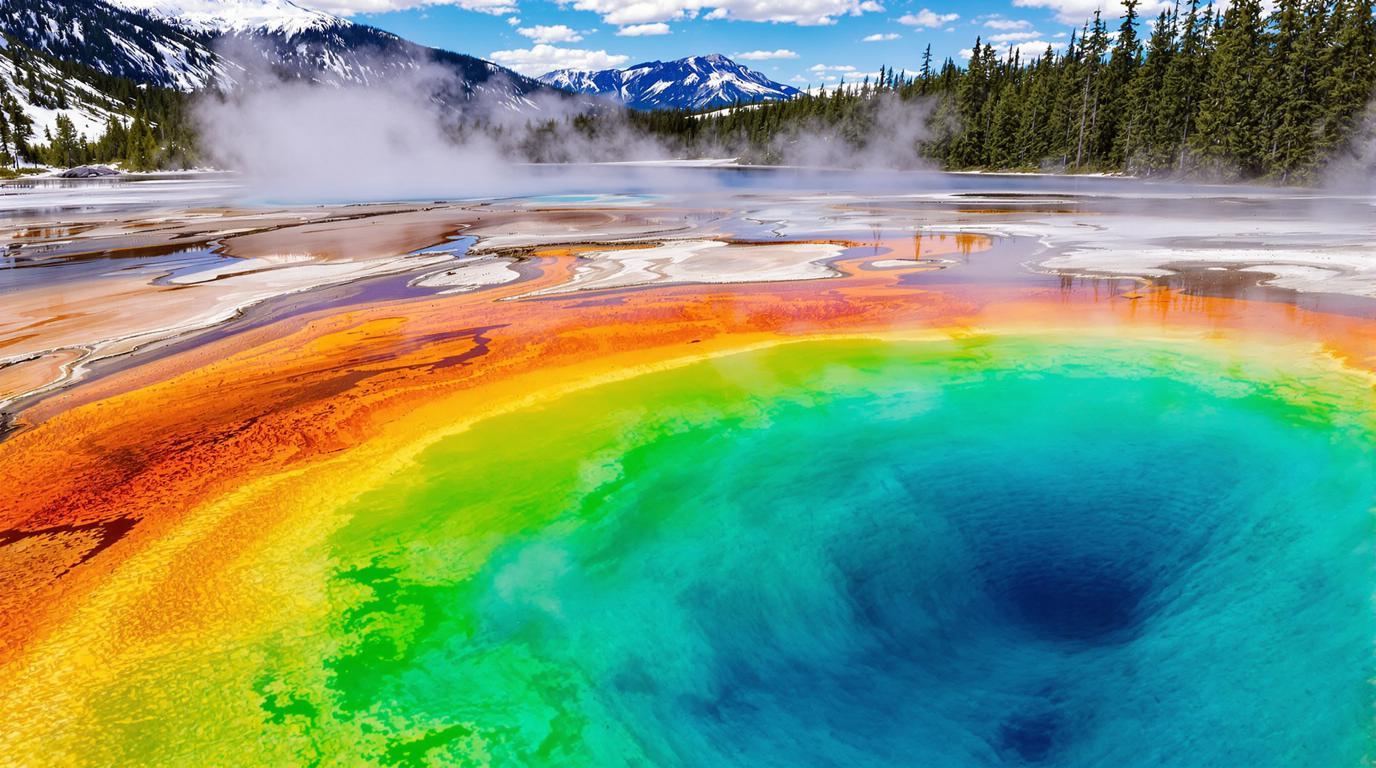Yellowstone National Park has been hiding a secret beneath its surface for millennia: a supervolcano capable of changing global climates if it erupts. But don’t panic – this sleeping giant has transformed its destructive potential into one of America’s most mesmerizing landscapes, attracting millions of visitors each year to witness nature’s most colorful laboratory.
America’s first national park: A pioneering legacy
Established in 1872, Yellowstone earned the distinction of becoming the world’s first national park. This revolutionary concept of preserving natural wonders for public enjoyment has since been replicated across the globe. The park spans an impressive 2.2 million acres across three states (Wyoming, Montana, and Idaho), creating a wilderness sanctuary larger than Delaware and Rhode Island combined.
The rainbow-colored hot spring that rivals any painting
Grand Prismatic Spring stretches 370 feet across—larger than a football field—with vivid blues in its center graduating to greens, yellows, and oranges around its edges. These mesmerizing colors aren’t photoshopped illusions but the work of heat-loving bacteria that thrive in different temperature zones. For a truly spectacular view, similar to how certain mountains transform at sunset, visit during midday when sunlight intensifies the colors.
Old Faithful: Nature’s timekeeper
While not Yellowstone’s largest geyser, Old Faithful has earned its fame through remarkable consistency. Every 90 minutes on average, this natural wonder launches thousands of gallons of steaming water up to 185 feet into the air, creating one of the park’s most photographed spectacles.
“The first time I saw Old Faithful erupt, I finally understood why people travel across the world to visit. It’s not just a geyser—it’s a reminder of the extraordinary forces beneath our feet,” shares Sarah McKenzie, a park ranger since 2011.
Lamar Valley: America’s Serengeti
Dawn breaks over Lamar Valley’s expansive meadows, revealing what locals call “America’s Serengeti.” This wildlife-watching paradise offers your best chance to spot Yellowstone’s impressive residents: grizzly bears, wolves, elk, and the park’s iconic bison herds. These massive creatures once roamed the continent in millions but were nearly hunted to extinction. Today, Yellowstone’s conservation success has rebuilt the population to around 5,000.
The technicolor terraces of Mammoth Hot Springs
Resembling a frozen waterfall, Mammoth Hot Springs showcases nature’s artistic talents as hot water deposits minerals layer by layer, creating terraced sculptures that continuously evolve. These limestone formations, which share geological similarities with other volcanic landscapes, grow at the astonishing rate of up to two feet per year.
The secret waterfall that rivals Victoria Falls
The Lower Falls of the Yellowstone River plunges 308 feet—nearly twice the height of Niagara Falls—into the colorful Grand Canyon of the Yellowstone. This spectacular waterfall creates mists that thunder through the canyon, and numerous viewpoints offer breathtaking perspectives of this hidden treasure.
Winter’s spectacular transformation
When snow blankets Yellowstone, visitor numbers plummet while magic soars. Geysers create ethereal ice formations, and rising steam paints ghostly landscapes against pristine white backdrops. Wildlife stands in stark relief against the snow, and lucky visitors might even glimpse the northern lights dancing above this frozen wonderland.
“Winter transforms Yellowstone into something otherworldly. The silence is profound, broken only by the hiss of geysers. It feels like discovering the park all over again,” explains Michael Thornton, winter tour guide.
The legendary wildlife encounters
Yellowstone houses the largest concentration of mammals in the lower 48 states. Beyond famous bison traffic jams, visitors report life-changing encounters with everything from playful river otters to majestic bull elk. One local legend tells of “The White Wolf,” an unusually large and pale alpha female who roamed the Lamar Valley for years, becoming a symbol of the park’s wildness.
Hidden romantic spots
While not promising eternal love like certain legendary arches in Greece, Yellowstone offers romantic souls secluded spots like Lone Star Geyser, reachable via a peaceful five-mile roundtrip hike, where couples can witness eruptions away from crowds. Shoshone Lake provides pristine backcountry camping for those seeking solitude under star-filled skies.
